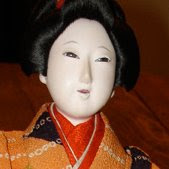I've been geeking out over Alexandre Piankoff's The Shrines of Tut-Ankh-Amon. Which is about (surprise), the theology and translations of the abbreviated religious texts on Tutankhamun's three nested shrines, canopic shrines, and other relevant bling.
I'm at the bit talking about the canopic shrines, and this has explained some interesting beleifs that I'd like to share.
The egyptians beleived that demons could take up residence in a person's vital organs before and after death. Since a person needs their liver, lungs, intestines, and stomach in the afterlife, important persons had theirs preserved, wrapped in linen and placed in special jars.
I have to wonder whether these demons were the Egyptians' way of explaining post mortem decay, or whether anti demon practices were intended to prevent Montezuma's Revenge in the Fields of Peace. There's probably a theological threat that possessed digestive tracts pose to the deceased, but I do not know what it is yet.
Anyway, a hint to how the Egyptians were thinking here can be found in a hieratic (cursive hieroglyphic) text in the British Museum. This is a spell to prevent demons from taking up in one's guts.
"Thou shalt not take thy stand in his liver, his lungs, in his heart, in his kidneys, in his spleen, in his intestines, in his rib, or in any flesh of his body. Imsety, Hapy, Duamutef, and Qebehsenuef, the gods who are in his body are against thee." (Piankhoff, 19)

Who are Hapy, Imsety, Duamutef and Qebehsenuef? They are the sons of the falcon god, Horus, who is the son of the God Osiris and his sister/wife Isis. At certain periods of Egyptian history, canopic jars featured images of these gods on their lids. Tutankhamun's canopic jars actually have portraits of him* on their lids, but the idea is still there. The idea is that these gods not so much protect these organs as are manifestations of them. Hapy is the lungs. Duamutef is the stomach, Qebehsenuef is the intestines, and Imsety is the liver. (Piankoff, 19).
Because the organs are manifestations of these gods, they need external protections to keep them demon and damage free. These "protections" come in the form of four goddesses: one for each son of Horus. It's interesting to note here that although each of these goddesses have their own mythology and function, ie. Neith is a very old war goddess, in the funerary tradition, they serve to protect the body and its components. In the case of Tutankhamun, protection comes in the form of tiny golden coffins, which each contain one of the canopic organs, and therefore "protect" the gods within these organs. Inside each of the coffins is an image of a protective goddess spreading her wings over the organs in protection. Isis protects Imsety(liver), Nephthys protects Hapy(lungs), Neith protects Duamutef(stomach), and Selkit, the one with the scorpion on top of her head protects Qebehsenuef. In fact, on the outside of these little coffins, the text reads along the lines of
"Words of [protective goddess]: 'I encircle with my two arms that which is in me. I protect [viscera god] who is within me. [Viscera god], the Osiris (here used to mean "deceased") King Nebkheperure (Tutankhamun), justified before the Great God.'" (Piankhoff, 19)
The little golden coffins are therefore manifestations of the goddesses** themselves, protecting the gods within them. If we move out a little, we can also see that the chest containing the little viscera jars and coffins has one of these four goddesses protecting each of the four corners--presumably the ones corresponding with her jar. Even the shrine wich encloses this canopic chest has a statuette of each goddess on each of its four faces.
So, if you happen to be going to see Tutankhamun and the Golden Age of the Pharaohs (sounds like a greatest hits album, doesn't it?) at the De Young Museum this summer, hopefully those little inlayed innard-coffins will be a little more meaningful to you than just another piece of King Tut's bling.
*Maybe.
**If you want to impress your friends, you can recognize the goddesses by the emblems on their heads. Isis often has a throne which looks like stairsteps. She also sometimes has cow horns with a disk between them, but usually it's the stairsteps. Neith has a shield with two arrows crossed behind it, but by the time of Tutankhamun it looks more like an oval with two curly lines comming out of each pointy end. Nephthys has a rectangle with a basket balanced on top of it. This spells Neb(t) Hwt, which is her name in Egyptian. Selket is the easiest to remember. She has a legless scorpion on top of her head.You do not mess with Selket.
Cited:
Piankhoff, Alexandre. The Shrines of Tutankhamun. Bollingen Series XL 2. Princeton University Press. Princeton, NJ 1977. pp19.
Cited by Piankhoff on the Demon Warding Spell in the British Museum,
Alan H. Gardiner. Hieratic Papyri in the British Museum. 3rd Series. Chester Beatty Gift ed. London, 1935.
Pictures from flickr with the photographer as Meechmunchie were taken by myself in the Egyptian Museum in Cairo. The others belong to their respective owners whom I thank for letting me ninja their photos.


No comments:
Post a Comment